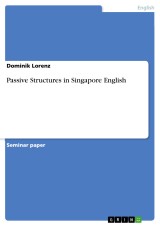Details

Passive Structures in Singapore English
1. Auflage
|
13,99 € |
|
| Verlag: | Grin Verlag |
| Format: | EPUB, PDF |
| Veröffentl.: | 02.05.2007 |
| ISBN/EAN: | 9783638719087 |
| Sprache: | englisch |
| Anzahl Seiten: | 16 |
Dieses eBook erhalten Sie ohne Kopierschutz.
Beschreibungen
Seminar paper from the year 2006 in the subject American Studies - Linguistics, grade: 2, University of Freiburg, course: Proseminar I, language: English, abstract: Ho and Platt (1993:1) argue that Singaporean English is a particularly interesting
indigenized, or nativized, speech variety because it is so widely used and fills so many
functions. I can confirm Ho and Platt’s statement, since I was in Singapore in 2004. It was not
difficult to notice Singapore English as a speech variety. This sparked my interest in
participating in the proseminar ‘English in Singapore’ and consequently in researching into a
certain grammatical phenomenon in Singapore English, namely the passive voice.
In this term paper, a short analysis of the two passive structures specific to Colloquial
Singapore English (the so-called kena passive and the give passive) will be presented. Further
on, we the get passive will be examined. We will show that give- and kena-constructions are
derived from the languages of Chinese and Malay, respectively. The bigger part of this paper
will be to examine the overall frequencies thereof. Which of the two passive constructions
will be closer in structure to the standard form? A personal analysis will help us to answer this
question, always with the hidden desire to finally come up with a reasonable conclusion
towards the end of the paper. We will probably have a winner of the competing substrate form
and we will hopefully find out which passive construction is the most productive one in
Singapore English.
Moreover, we want to compare the frequency of the kena-passive with the getpassive’s
frequency in a corpus-based analysis. Admittedly, the corpus-based study will be
relatively restrictive and not quite large in size. In addition, the give-passive will be ignored
due to its rarity.
Further on, we want to compare passive voice in Singapore with the passive in
Standard English. To manage this, after having presented the development of Singapore, its
multilingualism and English as its most common language, we will define some basic terms,
which will be used in this term paper. After that, we will explain the corpus and the
methodology used. In the end, we will sum up the findings and we will discuss my own study.
Perhaps, there are possibilities how to do it better next time or there are other things that could
be done.
indigenized, or nativized, speech variety because it is so widely used and fills so many
functions. I can confirm Ho and Platt’s statement, since I was in Singapore in 2004. It was not
difficult to notice Singapore English as a speech variety. This sparked my interest in
participating in the proseminar ‘English in Singapore’ and consequently in researching into a
certain grammatical phenomenon in Singapore English, namely the passive voice.
In this term paper, a short analysis of the two passive structures specific to Colloquial
Singapore English (the so-called kena passive and the give passive) will be presented. Further
on, we the get passive will be examined. We will show that give- and kena-constructions are
derived from the languages of Chinese and Malay, respectively. The bigger part of this paper
will be to examine the overall frequencies thereof. Which of the two passive constructions
will be closer in structure to the standard form? A personal analysis will help us to answer this
question, always with the hidden desire to finally come up with a reasonable conclusion
towards the end of the paper. We will probably have a winner of the competing substrate form
and we will hopefully find out which passive construction is the most productive one in
Singapore English.
Moreover, we want to compare the frequency of the kena-passive with the getpassive’s
frequency in a corpus-based analysis. Admittedly, the corpus-based study will be
relatively restrictive and not quite large in size. In addition, the give-passive will be ignored
due to its rarity.
Further on, we want to compare passive voice in Singapore with the passive in
Standard English. To manage this, after having presented the development of Singapore, its
multilingualism and English as its most common language, we will define some basic terms,
which will be used in this term paper. After that, we will explain the corpus and the
methodology used. In the end, we will sum up the findings and we will discuss my own study.
Perhaps, there are possibilities how to do it better next time or there are other things that could
be done.
Diese Produkte könnten Sie auch interessieren:

Politeness in Shakespeare: Applying Brown and Levinson´s politeness theory to Shakespeare's comedies

von: Abdelaziz Bouchara

43,00 €















